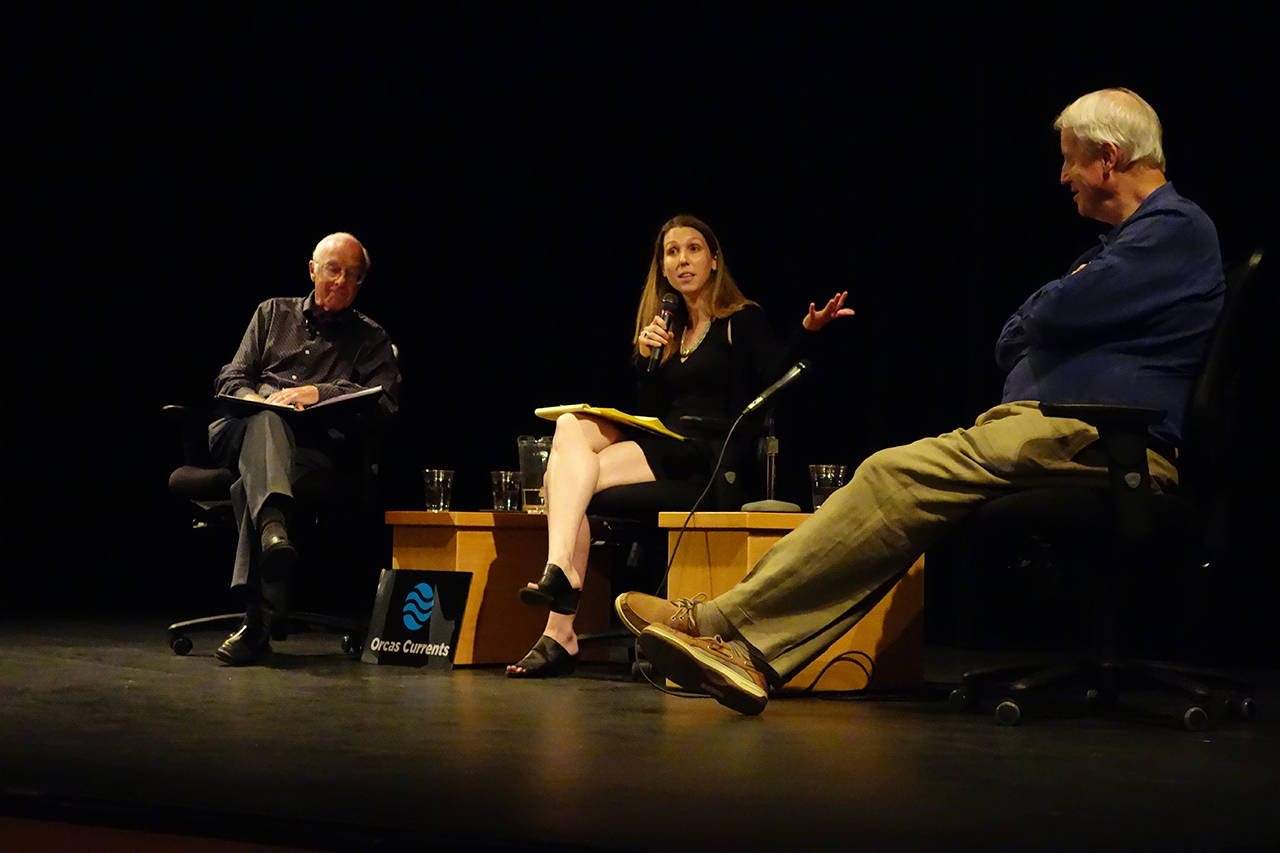“We have always had slander bias and we have always had political manipulation, but this seems to be something different,” said journalist and author Floyd McKay.
Orcas Center was packed with attendees spilling over into the overflow room for the lecture “The Future of Journalism in a Post-Truth Environment.”
McKay, a former Western Washington University journalism professor, moderated the discussion with award-winning journalists “The New Yorker” staff writer Sarah Stillman and PBS producer Hedrick Smith. The subject? Our nation’s current environment of fabricated news stories released by spurious outlets, lies issued by the White House and news being prioritized and disseminated by social media platforms; a lack of a business model to support rigorous journalism; and a general lack of civil ideological exchange in public discourse.
“At the beginning of the 2016 campaign, the press was asleep,” said Smith. But this year the press has been re-energized and the quality of journalism has risen, he added, “because YOU are interested. There are more people paying attention, who want to know what’s really going on.”
With the rise of technology, many people have come to think that the news should be free. And while there is plenty of fake or poorly researched news available for free out in cyberspace, it’s not cheap for trustworthy news organizations to travel, research, record, produce and meticulously fact-check their publications.
“People really want substance in the news they’re consuming,” said Stillman. “But it’s disheartening how little people appreciate the resources required.”
Smith, who in 1971 was already “The New York Times” Moscow Bureau Chief, remembers back when “we all had some kind of editorial standard,” including using only reliable sources; but “that began to break down with the advance of tabloid journalism,” he said. “Now customers don’t differentiate between organizations.” During the presidential election, Smith said, the Russians ran literally 1,000 fake news sites, continually pumping out entirely fabricated stories for Americans to peruse.
Stillman added, “It’s fundamentally a technology problem; young readers get their news directly through platforms (like Facebook), and they are the arbiters of what news gets seen.” These platforms use secret algorithms developed in Silicon Valley, and the net effect of weighting the clicks of crowds is that the news has “tilted itself toward clickbait.”
On the plus side, said Stillman, “We’re seeing the tremendous democratization of news-making,” and people with knowledge in their field can make real contributions to public awareness. There has been a great increase in the ability of people to publicize issues that matter to them, insisting that their stories be heard. That happened on social media for civilians in Syria and Egypt, noted Smith.
“When professional media spot real news, they move in and pick it up,” he said, and “real expertise” is needed to gather and judge facts and determine whether sources are trustworthy; “it’s the job of professionals to sort that out.”
One big problem, noted Stillman, is figuring out a viable business model to fund this level of expertise and fact-checking to bring truly reliable news to the public.
All three speakers acknowledged a trend in public discourse toward demeaning insults and a lack of common courtesy in speech – “a level of discourse most of us would not entertain in our living room,” noted McKay.
“Political dialogue is a hell of a lot more coarse than 15, 10, even five years ago,” said Smith. “We have obliterated any idea of shock.”
President Trump got repeated mention, with all three speakers referring to not just his coarse speech, but also the cascade of documented, provable falsehoods he has issued.
“This administration admittedly lies, and when caught, they don’t correct it,” said McKay, asking whether this might become “the new normal.” Smith and Stillman answered that it partially depends on whether politicians decide that the tactic “worked,” and whether Trump “got away with it.” And while Trump continues creating daily non-critical, yet shocking distractions for the public to gawk over, “some issues are getting almost no coverage,” said Stillman. “[Journalists] have got to hold his feet to the fire, to pay attention. We have got to be rigorous.”
As an instructor at the Columbia Graduate School of Journalism, Stillman said she sees a positive note – in response to what they’re seeing in government this year, journalism students are getting “riled up” with a new energy. “The glamor has come back,” she said, and these new members of the press are ready to play their role in helping keep our democracy healthy.
In this current climate of fake news, outright lies and lack of thoughtful, reasonable dialogue, Smith said he believes our democracy is in trouble. He thinks the current lack of civility in our country is partly rooted in partisanship and the gerrymandering of political districts to yield pre-determined ballot outcomes, removing the need to dialogue across party lines. Smith cites a recent comment by a U.S. senator, who said, “There’s nobody in the Senate dining room anymore.” Smith suggested we start at a grassroots level, by sitting down together and viewing one another as human beings, with a desire to listen and to connect across party lines, even though we might disagree on the issues.
“It’s been destroyed from the top down, but you rebuild it from the bottom up,” he said.
The bottom line, according to Smith, is this: “The quality of journalism depends on both of us, the audience and the journalists – you have to demand it, and you have to support it.”




